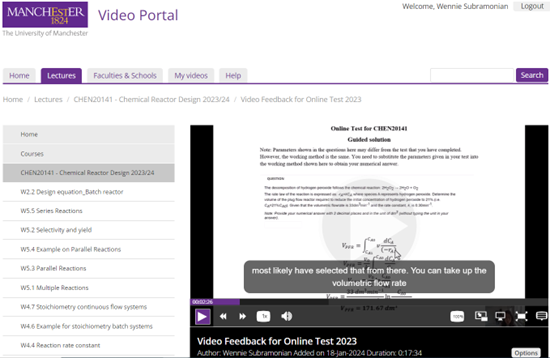
Why we should be giving feedback via video
Reasons for adopting video as an assessment feedback method plus how to implement it
You may also like
Popular resources
Traditional methods of giving feedback, often limited to written comments, can sometimes fail to fully engage students or clarify complex concepts. This is particularly true in STEM disciplines, where understanding problem-solving processes is essential.
The University of Manchester’s 2023 National Student Survey satisfaction score for assessment and feedback in chemical engineering was 67 per cent, whereas the top five chemical engineering institutions in the UK received scores between 78 and 82 per cent. Our score reflected the need for our department to review its feedback methods.
When I joined the engineering department in 2022, I was inspired to explore video as an assessment feedback tool to improve student understanding and engagement. With this and limited academic resources in mind, I have explored and implemented an actionable and accessible feedback strategy to enhance the learning experience, making it more interactive and tailored to students’ needs. This resource presents my motivation for adopting video as an assessment feedback method, the tangible implementation steps and the positive impact it has had on my students.
Why video feedback?
Traditional written feedback, while longstanding in academia, often lacks the dynamism and clarity necessary for deep understanding. Recent research outlined key limitations of written feedback:
- Impersonal and not engaging: according to research by Michael Henderson, Tracii Ryan and Michael Phillips, written comments can feel detached, reducing student engagement and their emotional connection to the feedback
- Prone to misinterpretation: David Boud and Elizabeth Molloy’s research found that complex concepts are hard to convey through text alone, leading to confusion and misinterpretation
- Lacks multimodal support: Paige Mahoney, Susie Macfarlane and Rola Ajjawi argue that written feedback misses the benefits of auditory and visual learning crucial for deep understanding of technical subjects.
Motivated by these insights, I adopted video feedback to provide a more dynamic and engaging experience for continuous assessments in my first- to third-year undergraduate taught units.
Implementing video feedback
Step 1: preparation
Before recording, prepare detailed solutions in Word or PDF (such as shown in Figure 1) to ensure a smooth and coherent explanation.

Step 2: recording
Using Camtasia, a screencast recording software, record your feedback with screen and audio commentary to provide step-by-step walkthroughs for solving each problem (Figure 2). Structure the feedback videos to emphasise common strengths and areas for improvement across the cohort, offering a comprehensive overview that benefits all students.

Step 3: upload and accessibility
To enhance accessibility, I upload the videos to the university’s video portal, where closed captions were automatically generated (Figure 3). The link to each video is then embedded in the relevant assessment and feedback folder on the unit’s virtual learning environment site, ensuring easy access (Figure 4). These videos can function as mini lectures, allowing students to revisit and review the material at their own pace. Timely feedback is crucial. In my case, I typically provide feedback within three working days of reviewing student submissions.
- Making feedback effective for your students and efficient for you
- What students told us ‘good’ feedback means to them
- Designing ‘knowledge checker’ quizzes that motivate students to review feedback and revise learning


Student feedback and engagement
The student response to my video feedback was very positive. They appreciated the clarity and depth of the video explanations. Many highlighted that the visual and auditory components helped them better understand the solutions compared with written feedback alone. Examples of comments shared from the unit evaluation questionnaires:
- “Great teaching and the new videos were great too! And the feedback for the online test was impressive! Really like the videos on how to solve all the test questions.”
- “Recorded solutions to tests and mock exams are really helpful as students are NOT MIND READERS when it comes to going through the model solutions.”
- “The feedback in general, both for the online test and coursework, was excellent and useful.”
My perspectives on the benefits of video feedback
Enhanced understanding: video feedback allows educators to provide a more thorough explanation, helping students grasp complex concepts more effectively.
- Flexibility: students can pause, rewind and replay the videos, allowing them to learn at their own pace
- Personal connection: the presence of an academic voice and face in the videos creates a more personal and engaging experience
- Problem-solving: videos facilitate better comprehension when solving the assessment question(s), covering common mistakes and best practices.
Incorporating video feedback into my teaching practice has proved to be a valuable tool in enhancing student learning and engagement. The positive impacts it has had on my students highlights its potential. As we continue to explore innovative ways to support student success, I am confident that video feedback will play a significant role in shaping the future of academic assessment.
Please do get in touch for more discussion surrounding teaching and learning enhancement strategies.
Wennie Subramonian is a lecturer in chemical engineering in the Faculty of Science and Engineering. She is the deputy programme director for the undergraduate programme in chemical engineering (2022-September 2024).
If you would like advice and insight from academics and university staff delivered direct to your inbox each week, sign up for the Campus newsletter.





Comments (1)
or in order to add a comment